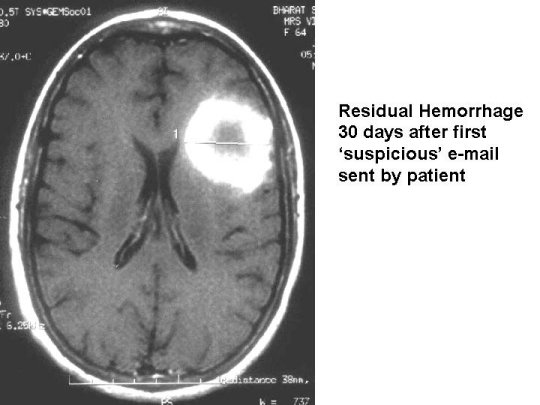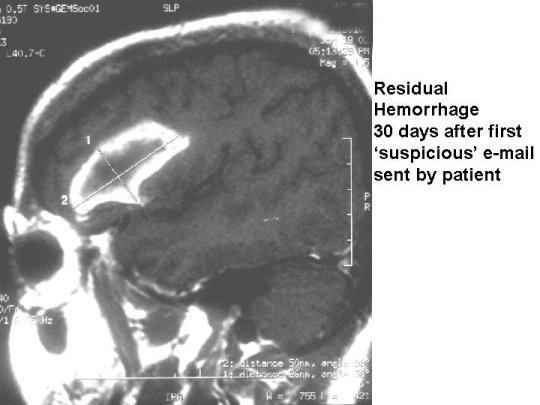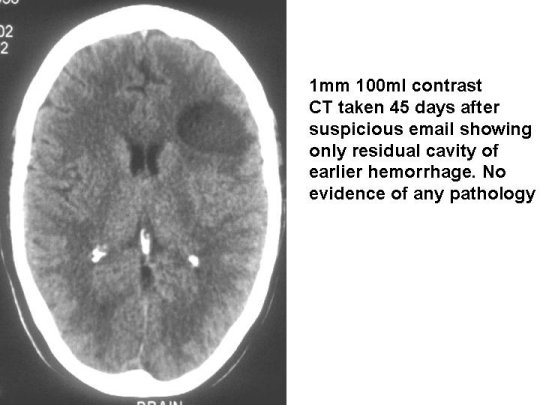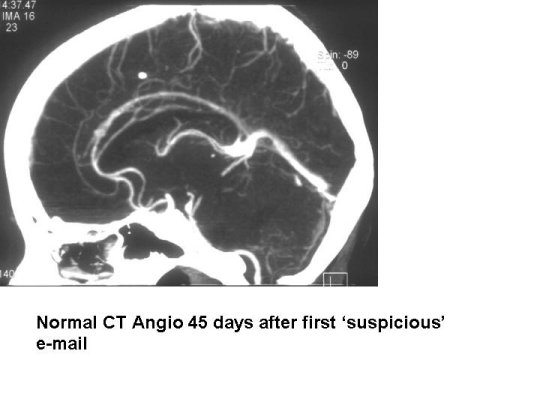CASE REPORT / CAS CLINIQUE
SUSPECTING NEUROLOGICAL DYSFUNCTION FROM E MAIL MESSAGES
SUSPISCION D'UNE AFFECTION NEUROLOGIQUE VIA UN MESSAGE EMAIL
- Dept of Neurosurgery, Sundaram Medical Foundation , Shanthi Colony, Anna Nagar, Chennai 600040, India
E-Mail Contact - GANAPATHY K. :
ABSTRACT
A non medical person suspected and confirmed neurological dysfunction in an individual, based only on e mail messages sent by the individual. With email communication becoming rampant “peculiar” email messages may raise the suspicion of neurological dysfunction. Organic pathology explaining the abnormal email messages was demonstrated – possibly due to an atypical hypertensive bleed or bleed from a self destructing cryptic vascular malformation.
Keywords: Cryptic AVM, E-Mail, Internet
RESUME
Le diagnostic d’un dysfonctionnement neurologique a été suspecté lors d’un échange d’e-mails entre parents. Il s’agissait d’un hématome intracérébral secondaire à une HTA ou à la rupture d’une malformation vasculaire cryptique.
CASE REPORT
Mrs V a 64 year old healthy educated woman was informed in mid December 2001 that her uncle had passed away. On hearing this, she became extremely upset. Discomfort and tightness of the head progressing to frontal headache developed. Since there was no previous history of headache, the mild headache which persisted for the next 3 weeks was attributed as a psychosomatic response to the passing away of her uncle – to whom Mrs. V was very closely attached. There was no history of prior trauma, seizures, vomiting or diplopia. There was no acute exacerbation of the headache, no loss of consciousness or neck pain. She had fever for 3 days after the commencement of the headache. Her husband a Ph.D and a retired professor of physics did not notice anything amiss. She was evaluated by a family physician for the slight headache and was put on paracetamol. The headache was not really too much of a problem.
Mrs V being computer literate was in the habit of frequently communicating with her daughter – a Ph.D student in biochemistry in the USA – through e mail. A few days after the headache was noted, the daughter received an email which was different from that normally sent by her mother (Enclosure1). The letters were not justified, the choice of words was not appropriate, the words were repeated and there were spelling mistakes besides errors in grammar and syntax. When the daughter continued to receive such emails she became concerned. To exclude the remote possibility that the repetition of words and occasional inclusion of nonsensical words was not due to a computer virus, the daughter requested a friend to send an email from the same computer. The mails were normal. The daughter was reassured by the father, that there was no problem with her mother, who was apparently leading a normal life. The family physician confirmed this. The daughter was however convinced that her mother would not send such emails unless there was something wrong with her – some neurological problem. The daughter decided to come to Madras and insisted that her mother have a scan. After seeing the scan neurosurgical consultation was sought.
When clinically evaluated (thirty five days after the original suspicious emails had been sent) Mrs V was alert and oriented. She had no specific problems. The occasional mild headache did not really bother her. She had a just perceptible (?) facial weakness on the right side. Deep tendon jerks on the right side were brisk. Plantar was flexor on the left and equivocal on the right. There was no other deficit. Higher functions and cortical sensations were apparently normal. There was no perseveration or word finding difficulty. She was able to write and copy clearly. She could identify mirror images.
Past history included history of aspiration of a cyst in the right breast in 1985 and 1990 followed by ennucleation of a cystic mass from the right breast in November 2000. Frozen section at that time revealed cystosarcoma phylloides with a few areas of metaplasia. FNAC done in Nov 2001 following a mammogram revealed no malignancy. Mild hypertension has been under control with medication. Detailed neuropsychological evaluation done after seeing the MRI (fig 1,2,3) revealed normal verbal skills ( non verbal reasoning, visual memory, visuo constructive skills, and visual perceptual/ visual spatial skills) . Significant under functioning of the verbal IQ – marked scatter between verbal and non verbal IQ with significant under functioning of short term memory and verbal immediate and recall memory was noticed. There was word retrieval deficits, more pronounced on descriptive and spontaneous speech.
DISCUSSION
The MRI taken 35 days after the first “suspicious” emails were sent revealed sub acute hemorrhage in the left frontal region. There was nothing to suggest that this was secondary to a primary tumour or an atypical secondary deposit or a vascular malformation. There was no history of trauma or a hypertensive crisis. There was no hematological dysfunction or evidence of a secondary elsewhere. A contrast spiral CT with 1mm slices and a CT angiogram (done 45 days after the initial mild headache) revealed only a hypodense area compatible with possible previous hemorrhage.( fig4/5) . Follow up contrast CT with 1mm slices taken 5 weeks after this scan , ( about 85 days after the first suspicious e mail, revealed further absorption reduction of the residual hemorrhage. There was no abnormal vasculature or any findings to suggest any other pathology. ( fig 6).
It was therefore concluded that the sub acute hemorrhage seen on the initial MRI was probably secondary to a cryptic self destructing vascular anomaly. This however is conjectural. The natural history of cryptic vascular malformations is uncertain and treatment remains controversial (1). Neither CT nor MRI can provide an accurate or reliable diagnosis of an angiographically occult vascular malformation.(2,4) Unless meticulous search for microangioma under magnification is carried out in cases of “spontaneous” haematoma these lesions can easily be missed. (4). These small-sized angiomas are buried in the wall of the haematoma cavity (2) Weisberg (5) in a review of 200 cases of spontaneous intracerebral hemorrhage reported nine young patients who had CT evidence of an acute hematoma but no angiographic or pathological evidence of abnormal vessels; and it was postulated that these probably represented cryptic vascular malformations or aneurysms.
The possibility of the bleed being secondary to hypertension appears unlikely though it cannot be completely excluded. There were no systemic features of raised hypertension and blood pressure recordings were always within normal limits. Anti hypertensive medication was also being taken regularly The e mails sent by Mrs V (following resorption of the hemorrhage) were once again normal (Enclosure 2) confirming that the “abnormal” emails sent during the time of the mild headache was a consequence of the hemorrhage in the left frontal lobe. It is difficult to explain how no other abnormality in speech or behaviour was detected by her family or friends at that time in spite of a fairly large hematoma in the left frontal lobe. It is known that the neuronal circuits responsible for translating thoughts into a typed ( written) word is different from the circuits responsible for translating thoughts into the articulated word. Such selective neuronal dysfunction appears improbable but perhaps not totally impossible. It is possible that but for the e mail messages the mild headache may not have been investigated. Even though a family physician had evaluated the patient nothing was really picked up and even an educated husband had not noted anything amiss. The hemorrhage would have got absorbed and along with this the mild headache would have resolved. The e mail messages alone indicated left frontal dysfunction. No obvious perseveration, speech deficit or alteration in behaviour was noted by any of the educated relatives or friends or the family physician at the peak of the hemorrhage. By the time neurological dysfunction was suspected and higher functions evaluated in detail, the hemorrhage was already getting absorbed.
With email communication becoming rampant abnormal e mail messages may offer evidence of neurological dysfunction in eloquent areas. The problem assumes importance because in a country like India there is an increasingly large number of senior citizens living alone, with their children residing overseas In developing countries internet telephony, chatting and e mail are no longer the privilege of the elite. In the future as in this case, these methods of communication may offer the first clue to disturbance of higher functions
E mail sent 4 days after headache
Dec. 14th
dear lalita, recd your mail.
radha has promised to come over next Friday, when the court vacation
Starts. i made idlis for dinner today as today is amavasya. there was a news in the paper saying experimentally they are not able to see the higg’s boson. appa feels strong about his paper. he wants to send it to japan where they are still working on this project. this is what I understood from what he said.
Ttat is all for today. take care. love amma.
E mail sent 9 days after headache
dear lalita,
it was not rising clear pati was not able to clear what you were saying. sankar came over last eaevning. I went to last evening in the evening. i got some evening, he gave me some evening, just after that it became last evenining. Anything was not clear now I am a able to clear every thing. the chiththappa ws having and had his clearing was ok. they suddenly she called The evening and they called the evening and he came near by . but within few mts, he passed away. parwatha was passing away at bangalore, she had to take a birth and leave and came back. so we had to come back till she came back. finally i came back by the time i came back. appa had back after I came back. so every thing was back. that is all for now. take care now. that is for now sulochi
E mail sent 11 days after headache
dear lalita, i am fine. i am fine. I am fine i happy and sorry for thiruppur chiththappa. they good have given some more time. that is all for some time. that is all for time some. more later and short more. more later. that is all .that is all taken fine love amma
E mail sent 17 days after headache
dear lalita, recd your message. radha is here. she is better. i don’t think she is better. she needs to better. we are all here fine, that is all for now. take later, thank you. fine more amma
E mail sent 65 days after headache
Date: Mon, 18 Feb 2002 22:17:18 +0530
Dear Dr. Ganapathy,
I shall be writing a casual mail to you. It was nice of you to ask me to write to you. I have stopped shopping and going alone anywhere on my own. I just do the cooking and take care of the door. I have some friends who either call or send me mails. So I keep myself answering them. As I have stopped other outside jobs, I find it difficult to spend time.I would like to know what is wrong with me when I meet you next time. I am not very clear about the incident as you talked with my daughter. Thank you for the same. _ Sincerely Visalakshi






REFERENCES
- CIRICILLO SF, COGEN PH, EDWARDS MS. Pediatric cryptic vascular malformations: presentation, diagnosis and treatment. Pediatr Neurosurg. 1994;20(2):137-47.
- PRAKASH B, BEOHAR PC, MiSRA RC. Low flow (cryptic) arteriovenous malformation and spontaneous haematoma. Acta Neurochir (Wien). 1983;69(1-2):61-7.
- SHUEY HM Jr, DAY AL, QUISLING RG, SYPERT GW. Angiographically cryptic cerebrovascular malformations. Neurosurgery. 1979;5:476-9.
- SZE G, KROL G, OlSEN WL, HARPER PS, GALICICH JH, HEIER LA, ZIMMERMAN RD, DECK MD. Hemorrhagic neoplasms: MR mimics of occult vascular malformations. Am J Roentgenol. 1987;149:1223-30.
- WEISBERG LA. Clinical and computed tomographic findings in thrombosed and cryptic cerebrovascular malformations. Comput Radiol. 1982;6:161-70.